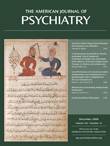Clinical Trial-Based Cost-Effectiveness Analyses of Antipsychotic Use
Abstract
Objective: Second-generation antipsychotics make up one of the fastest growing segments of the rapidly growing pharmaceutical sector. Given limited health care resources, assessment of the value for the cost of second-generation antipsychotics relative to first-generation antipsychotics is critical for resource-allocation decisions. Method: With a MEDLINE search, the authors identified eight studies (based on six randomized clinical trials) that analyzed the cost-effectiveness of second-generation antipsychotics relative to first-generation antipsychotics in individuals with schizophrenia disorders. The authors reviewed appropriate methods of measurement, analysis, and design of cost-effectiveness studies in randomized clinical trials and evaluated the validity of economic results derived from the studies in light of appropriate methods. Results: The eight randomized clinical trial-based cost-effectiveness studies of antipsychotic medications faced a variety of threats to validity related to 1) measurement of costs, 2) measurement of effectiveness, 3) analysis of costs, 4) measurement of sampling uncertainty, 5) analysis of incomplete cost data, 6) minimizing loss to follow-up, and 7) threats to external validity. Conclusions: Economic claims made by the authors of a number of trial-based economic evaluations have generally been favorable to second-generation antipsychotics. However, the methodological issues the authors of the current study identified suggest that there is no clear evidence that atypical antipsychotics generate cost savings or are cost-effective in general use among all schizophrenia patients. Psychiatrists, researchers, and administrators should consider the methodological issues highlighted in interpreting study results. These issues should be addressed in future trial designs.



